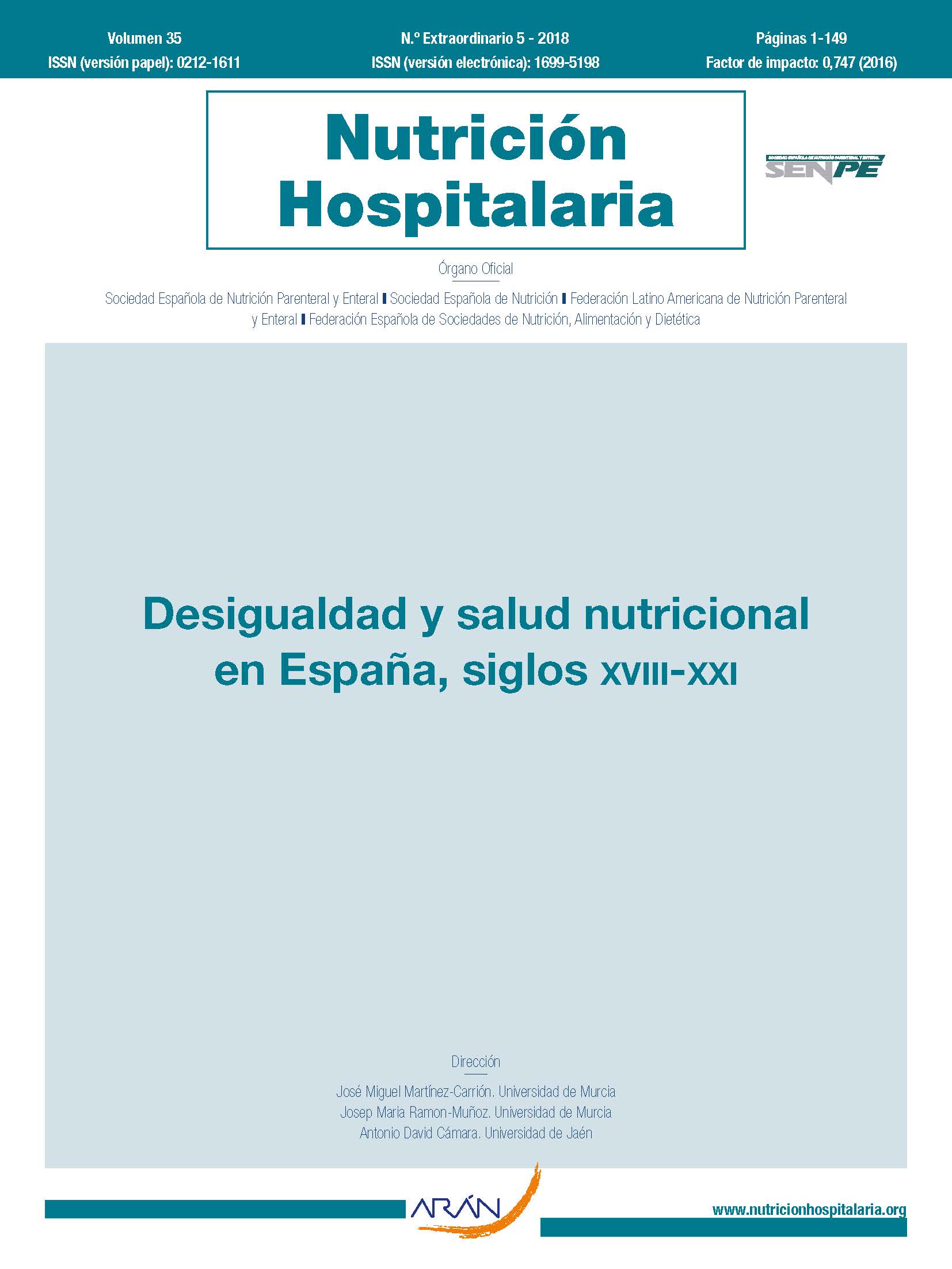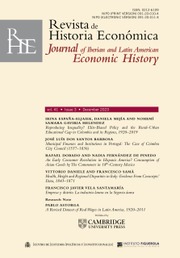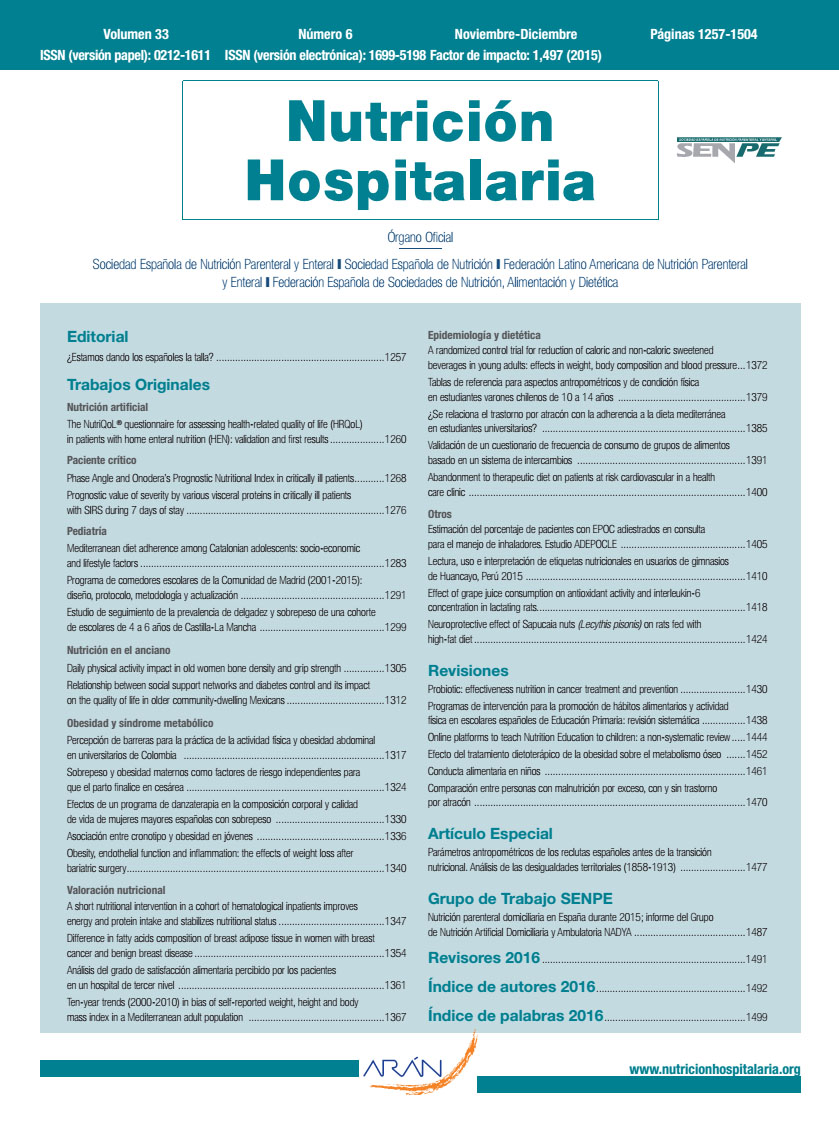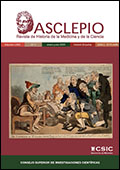
Cañabate Cabezuelos, José y Martínez-Carrión, José Miguel (2018): “Crisis nutricional y brecha social en la España de la autarquía. Un estudio de caso a partir de la talla adulta”, Nutrición Hospitalaria, 35 (n.º extra 5), pp. 108-115.
Abstract: Objectives: this article examines the nutritional crisis and the social gap during Franco’s autarky. It considers the municipality of Hellín (Castilla-La Mancha), prototype of traditional agrarian population. Methods: use the stature of 8,947 men measured at ages 20-21 years between the military recruits of 1930-1969. Analyze the differences in height by rural-urban residence, education and occupation. The professions are grouped according to the Hisco-Hisclass methodology in five large groups. Results: the height per year of replacement registered a deterioration at the end of the Civil War and stagnated until 1953. The highest value of the 1930 decade (1937) did not recover until 1960. The rural-urban gap was barely significant, although the average of the urban height was in values slightly higher than the rural one and it increased for those born in the autarky. The illiterates were lower than the literate and their differences increased for those who lived their initial adolescence between 1930 and 1955. The deterioration of height in the 1940s was higher for less skilled workers and agricultural day laborers, lower for farmers (farmers) and, barely significant for more skilled non-manual workers, including elites. This group was the one that most progressed in physical well-being between 1930 and 1960. Conclusions: the nutritional status worsened for those who lived through the beginning of their adolescence in the 30s and 40s. The social gap, including the educational one, increased during the 1940s. Nutritional inequality increased in the Francoist autarchy.

Cámara, Antonio D. y Martínez-Carrión, José Miguel (2018): “La evolución de la desigualdad del estado nutricional al sur de la Comunidad Valenciana: un análisis antropométrico de Elche y Orihuela entre 1840 y 1984”, Nutrición Hospitalaria, 35 (n.º extra 5), pp. 69-75.
Abstract: Introduction: many studies have used anthropometric data to approach the evolution of the net nutritional status but those focused on its socioeconomic differentials over time are still a few in Spain. Objective: to analyze the evolution of nutritional inequalities in the long run by using a sample of male statures from the Spanish towns of Elche and Orihuela. Methods: we use anthropometric and sociodemographic data entailed to conscripts aged 19-21 who were born between 1840 and 1964 and were measured between 1860 and 1984. Anthropometric inequalities are approached by analyzing height percentiles series, variation coefficient series as well as height series by socio-educational status: literate, illiterate and students. Results: there is a solid association between low height averages (poor nutritional status) and more heterogeneous height distribution (higher inequality). The highest values of the variation coefficient as well as the larger differences by socio-educational status are found during the central decades of the 19th century and during the context of the Spanish Civil War and the first postwar decade. Conclusion: nutritional inequalities as reflected by heights decreased from very high levels prior to the nutrition and epidemiological transitions moderate levels during such transitions. Nevertheless, an increase in nutritional inequality is found among the cohorts born during the decade of the 1940s which were fully or partially raised during the advanced stage of the nutrition transition.
 Puche, Javier, Ayuda María-Isabel, y Martínez-Carrión, José Miguel (2018): “Estatura y desigualdad nutricional en la España rural mediterránea, 1840-1965: regadío frente a secano”, Nutrición Hospitalaria, 35 (n.º extra 5), pp. 63-68.
Puche, Javier, Ayuda María-Isabel, y Martínez-Carrión, José Miguel (2018): “Estatura y desigualdad nutricional en la España rural mediterránea, 1840-1965: regadío frente a secano”, Nutrición Hospitalaria, 35 (n.º extra 5), pp. 63-68.
Abstract: Introduction: since the 2000s the nutritional status of Spanish rural populations has been studied by anthropometric history. But despite this undoubted progress, we hardly have comparative studies on the height and biological inequality between agrarian zones of different productive specialization (irrigated and dryland agriculture). Objectives: to analyse the nutritional inequality in agrarian zones of different productive specialization in Mediterranean Spain (irrigated and dryland agriculture) during the process of modernization. Methods: we use height data of 146,041 conscripts called for recruitment in ten municipalities (72,557 in irrigated areas and 73,514 in dryland areas). We estimate average height, coefficients of variation and percentiles according to agrarian specialization. Results: between the cohorts of 1840 and 1965 the nutritional status improved. The average height grew 9.1 cm. The conscripts measured in the irrigated areas were higher than the conscripts measured in the dryland areas (differences of 1.8 cm). At the end of the study period, the average height growth was greater in the irrigated ones. The analysis of coefficients of variation (CV) and percentiles show, however, that the nutritional inequality was greater in dryland areas. Conclusions: there are significant differences in the average height according to patterns of agrarian specialization in Mediterranean Spain and a clear relative advantage in irrigated areas versus dryland. Various explanatory factors that could be future research lines are discussed.

Ramon-Muñoz, Ramon & Josep-Maria Ramon-Muñoz (2018): “Biological Standards of Living in Rural Catalonia over the Long Run: A Comparison with Urban Areas (1840-1960)”, Nutrición Hospitalaria, 35 (n.º extra 5), pp. 54-62.
Abstract: Objective: to assess the long-term evolution of biological living standards in rural Catalonia and to compare it with the corresponding figures in urban areas. Methods: using data from military records of conscripts from six towns in western Catalonia, we construct an annual height series. Height is standardised at the age of 21 years. We also construct a body mass index (BMI) for conscripts born in 1891 and 1934-39. The annual height series for western Catalonia is systematically compared to the series for Reus, Catalonia’s second largest city during the second half of the 19th century. Results: comparing the cohorts born in the periods 1840-49 and 1951-60, we find that height increased by 5.7 centimetres over this period. However, the increase was not distributed equally over time. In the second half of the 19th century, rural heights stagnated over the long run and declined relative to urban heights. In the cohorts born in the decades between 1910 and 1950, rural heights rose by more than 5 centimetres, and converged with those of Reus. Conclusion: we provide new evidence for the current debate on the rural-urban height gap. Between the 1840s and the 1950s, heights in rural western Catalonia grew at rates similar to those recorded in certain urban areas, but growth rates differed depending on the period of analysis. This study underlines the importance of adopting long-term perspectives, and stresses that rural-urban height differences tend to be time-and space-specific.

Martínez-Carrión, José Miguel, Cámara, Antonio D. y Ramon-Muñoz, Josep-Maria (2018): “Nutrición y desigualdad en el largo plazo: ¿qué enseña la historia antropométrica sobre España?”, Nutrición Hospitalaria, 35 (n.º extra 5), pp. 1-10.
Abstract: This article underlines the relevance of anthropometric history among the disciplines concerned with health and nutrition. The examination of changes on the nutritional status and inequality in Spain focused the 4th Anthropometric History Workshop held at the beginning of 2018 where 18 original contributions were presented and discussed. We first show the ability of human stature to approach the impact of socioeconomic processes and environmental changes on the nutritional status over the last centuries. Then it is proceeded to present the main contents and advances achieved in the workshop. The papers coped with diverse dimensions of inequality regarding nutritional health and its determinants since the end of the 18th century until 2015. Aside of height and weight at different ages, principally adult ones, others anthropometric indicators were analyzed such as sexual dimorphism and low weight at birth. The results illustrate the large prevalence of malnutrition and social inequality in past Spain. These problems persisted over a good part of the 20th century (i.e. stunting) and, they acquired a different nature since the 1980s as the increasing prevalence of overweight and obesity reveals. It is concluded that the determinants of nutritional status and health-related inequalities request multidimensional approaches and the dialogue between social sciences and biomedical sciences. Knowing about their dimensions in the past and their evolution over time provides a valuable basis in order to understand current problems in these areas and to address future public policies more adequately on childhood and adolescence.
 Martínez-Carrión, José M. y María-Dolores, Ramón (2017): “Regional Inequality and Convergence in Southern Europe. Evidence from Height in Italy and Spain, 1850-2000”, Revista de Economía Aplicada, 74, vol. XXV, pp.75-103.
Martínez-Carrión, José M. y María-Dolores, Ramón (2017): “Regional Inequality and Convergence in Southern Europe. Evidence from Height in Italy and Spain, 1850-2000”, Revista de Economía Aplicada, 74, vol. XXV, pp.75-103.
Abstract: This paper analyses the growth in height and its regional variability in Spain and Italy between the generational cohorts of 1850 and 1980. Using male height data drawn from the military enlistment records of the period between 1870 and 2000, this paper explores inequality and regional convergence in both countries. This long period was characterised by economic growth and the increase of human welfare. Regional inequality and convergence are analysed using sigma and beta convergence, a methodology based on panel data to obtain the speed of convergence. The results show that in 1850 height measurements started at low levels, but the two countries recorded a significant increase in the average height over the long term, which became more intense in Italy from the beginning of the twentieth century and in Spain from 1950. Therefore, there was divergence in the first half of the century and strong convergence at the end of the century. Regional inequality was more significant in the Italian case. Processes of regional convergence can be observed in both countries during the second half of the twentieth century, although inequality was lower in Spain than in Italy at the end of the period.
 Ramon Ramon-Muñoz & Josep-Maria Ramon-Muñoz (2017): “Sibship size and the biological standard of living in industrial Catalonia, c.1860–c.1920: a case study”, The History of the Family, no. 22 (2-3), pp. 333-363. doi: 10.1080/1081602X.2016.1224727.
Ramon Ramon-Muñoz & Josep-Maria Ramon-Muñoz (2017): “Sibship size and the biological standard of living in industrial Catalonia, c.1860–c.1920: a case study”, The History of the Family, no. 22 (2-3), pp. 333-363. doi: 10.1080/1081602X.2016.1224727.
Abstract: By using military records and population censuses this article investigates the relationship between sibship size and the biological living standards of young males, as measured by height. Focusing on a medium-sized industrial town in Catalonia the analysis shows that the impact of sibship size on child outcomes, as hypothesised by the resource dilution explanation, was rather weak during the years of the first fertility transition. Sibship size affected the height of young males only in certain socioeconomic groups and in specific periods of time, and not always in the expected direction. The article also explores the potential role of confounding factors in the link between sibship size and height, as well as the complexity of this relationship.
Cañabate-Cabezuelos, José & Martínez-Carrión, José Miguel (2017): “Poverty and Rural Height in Inland Spain during the Nutrition Transition”, Historia Agraria, 71, pp. 109-142.
Abstract: This article analyses nutritional inequalities and stunting in the rural interior of Spain based on a case study carried out in the region of Castile-La Mancha. By examining the height of military draftees, the evolution of growth patterns is revealed, and the gap between the stature of the urban and rural populations is analysed. The results indicate that stunted growth and undernourishment were pervasive during the two initial decades of the twentieth century; the situation improved slightly in the 1920s and the first half of the 1930s; and in the 1940s and 1950s the conditions again deteriorated considerably. Stunted growth was significant especially in rural areas, which suffered particularly during the Franco regime. Height increased considerably in the 1960s and 1970s and, although this improvement also reached the rural areas, the gap between the countryside and the urban areas did not disappear until the early 1980s.The data suggest that key factors in the evolution of physical growth were a poor and limited diet, the economic policies implemented by the Regime and the institutional framework related to social assistance. Finally, also suggest the need to extend the study beyond children to examine the circumstances of adolescents, along with the need to investigate social inequality among different professional groups during the nutritional transition.
 María-Isabel Ayuda & Javier Puche (2017), “Biological welfare and nutritional inequality in rural Mediterranean Spain: the irrigated area of Valencia, 1859-1939”, Revista de Historia Económica – Journal of Iberian and Latin American Economic History, doi: https://doi.org/10.1017/S0212610916000185 (Published online: 09 January 2017).
María-Isabel Ayuda & Javier Puche (2017), “Biological welfare and nutritional inequality in rural Mediterranean Spain: the irrigated area of Valencia, 1859-1939”, Revista de Historia Económica – Journal of Iberian and Latin American Economic History, doi: https://doi.org/10.1017/S0212610916000185 (Published online: 09 January 2017).
Abstract: This article analyses the biological welfare and inequality of the male population of the irrigated area of Valencia between 1859 and 1939. It studies the effects that the agrarian development process had on physical welfare and the relationship between height and access to land ownership. Height data for conscripts in five municipalities constitute the source for the study. The results reveal that there was a growing trend in the evolution of heights in the irrigated area of Valencia at the beginning of agrarian capitalism. Nutritional inequalities can be observed between farmers and farm workers: land owners were taller than landless labourers. However, this biological inequality diminished over the period under study.
 Martínez-Carrión, José Miguel; Cámara, Antonio D. & Pérez-Castroviejo, Pedro M. (2016): “Parámetros antropométricos de los reclutas españoles antes de la transición nutricional. Análisis de las desigualdades territoriales (1858-1913)”, Nutrición Hospitalaria, vol. 33 (6), pp. 1477-1486.
Martínez-Carrión, José Miguel; Cámara, Antonio D. & Pérez-Castroviejo, Pedro M. (2016): “Parámetros antropométricos de los reclutas españoles antes de la transición nutricional. Análisis de las desigualdades territoriales (1858-1913)”, Nutrición Hospitalaria, vol. 33 (6), pp. 1477-1486.
Abstract: Objective: The article explore the regional pattern of nutritional status and its evolution between the middle of the 19th century and the beginning of the 20th century in Spain. This period precedes the nutrition transition and it was characterized by the high prevalence of malnutrition. Methods: We use anthropometric data (province-level height means) from conscription in 1858 y 1913 as well as province-level means of height and weight from a large examination held among 119,571 soldiers in 1903-1906. These data are used to construct anthropometric cartography and descriptive statistics. Results: The complexion of Spanish conscripts as indicated by height and weight measures was among the lowest in Europe prior to the nutrition transition in this country. Male average height increased only 1.43 cm between 1858 and 1913. During that period significant changes in the anthropometric geography occurred in Spain which established a nutritional polarity on the eve of the World War I (WWI): inner and Southern provinces exhibited higher incidence of malnutrition whereas provinces in the North and East of the country displayed anthropometric figures above the national average. Conclusion: Spatial inequalities of nutritional status in Spain as reflected by anthropometric polarity may be largely associated with environmental changes. Such changes are related to the modernization and industrialization processes in this country at the time that a relative backwardness (e.g. economic and technological), structural scarcity, occasional subsistence and high exposure to illness persisted. Our results underline the utility of anthropometric data to approach the living conditions of past population and the process of nutrition transition in particular.
 José Miguel Martínez-Carrión (2016): “Living Standards, Nutrition and Inequality in the Spanish Industrialisation. An Anthropometric View”, Revista de Historia Industrial, 64, pp. 11-50.
José Miguel Martínez-Carrión (2016): “Living Standards, Nutrition and Inequality in the Spanish Industrialisation. An Anthropometric View”, Revista de Historia Industrial, 64, pp. 11-50.
Abstract: This article presents an overview of the study of living standards in Spain from the perspective of anthropometric history and new data from recent research. The aim is to examine changes in nutrition during the industrial age through anthropometric indicators. The paper provides new evidence on the changes in height among different socioeconomic groups and its relation with health and human well-being in different periods and geographical regions. It also explores inequality before and during the process of industrialisation. In addition to tracking the effects of environmental changes on well-being and inequality between the proto-industrial period in the eighteenth century and the industrial leap in the beginning of the second half of the twentieth century, it explores the costs of industrialisation in biological standards of living in the short- and the long-term. Finally, it suggests future directions of research.
 Ramon Ramon-Muñoz & Josep-Maria Ramon-Muñoz (2016): “The Biological Standard of Living in Nineteenth-Century Industrial Catalonia: A Case Study”, Revista de Historia Industrial, 64, pp. 77-118.
Ramon Ramon-Muñoz & Josep-Maria Ramon-Muñoz (2016): “The Biological Standard of Living in Nineteenth-Century Industrial Catalonia: A Case Study”, Revista de Historia Industrial, 64, pp. 77-118.
Abstract: Drawing on anthropometric information, this article investigates the evolution of the biological standard of living in nineteenth-century Catalonia. We focus on the city of Igualada, one of Catalonia’s main textile centres in the early part of the century. The results show a decline in the height of males born between the 1830s and the 1860s, the period in which factory-based industrialisation emerged and became consolidated. The article also suggests that height inequality rose during the third quarter of the nineteenth century. The empirical evidence gathered provides further support for the pessimistic view of the evolution of the standard of living during the early stages of industrialisation.
 Javier Puche & José Cañabate-Cabezuelos (2016): “Did Physical Stature Diminish During Spain’s Early Industrialisation? The Case of Alcoy, 1840-1915”, Revista de Historia Industrial, 64, pp. 119-147.
Javier Puche & José Cañabate-Cabezuelos (2016): “Did Physical Stature Diminish During Spain’s Early Industrialisation? The Case of Alcoy, 1840-1915”, Revista de Historia Industrial, 64, pp. 119-147.
Abstract: This paper looks at the effects of early industrialisation in Spain on biological living standards. The case study focuses on Alcoy, one of the towns that pioneered Spanish industrialisation in the nineteenth century. Based on anthropometric data for the height of military conscripts between 1860 and 1936 (cohorts born between 1840 and 1915), the study shows that average stature diminished among the generations born in the 1860s and 1870s, coinciding with the early stages of mechanisation in the textiles industry and accelerating urbanisation. However, poor diet among the inhabitants of Alcoy’s rural hinterland was a further contributing actor to this decline in stature. The anthropomorphic evidence suggests that early industrialisation in Alcoy worsened health conditions and the net nutritional status of the town’s working class.
 Miguel A. Pérez de Perceval Verde, José Miguel Martínez-Carrión & Ángel Pascual Martínez-Soto (2016): “Biological Welfare and Inequality During the Mining Boom: Rio Tinto, 1832-1935”, Revista de Historia Industrial, 64, pp. 149-181.
Miguel A. Pérez de Perceval Verde, José Miguel Martínez-Carrión & Ángel Pascual Martínez-Soto (2016): “Biological Welfare and Inequality During the Mining Boom: Rio Tinto, 1832-1935”, Revista de Historia Industrial, 64, pp. 149-181.
Abstract: This study explores the impact of the mining boom on the biological standards of living and inequality in Rio Tinto, the main copper basin in Spain. It uses the heights of military recruits in the towns of Zalamea la Real and Nerva between 1852 and 1935 (birth cohorts of 1832-1914). The majority of the mining population of Nerva, which had become independent from Zalamea la Real in 1885, was concentrated close to Minas de Riotinto, following the extraordinary influx of immigrants, mostly attracted by the British company RTCL after establishing its operations there in 1873. The anthropometric results reveal that: 1) the height of males decreased slightly among the cohorts of the decades 1850-1870, whose childhood and adolescence coincided with the beginning of the mining boom; 2) the inequality (measured by CVs, percentiles and ratios of short-stature subjects) increased among the cohorts of the 1870s, made up of immigrants, principally in Nerva. During this period, the gap between the height of the native population and the immigrants also increased, as did the gap between the literate and illiterate populations. Finally, 3) the improvement in the biological welfare of the cohorts corresponding to 1880-1890 was undermined in the subsequent decades due to the impact of the mining crisis. In the lead-up to the Great War, the height of the miners in Nerva was no different to that of the rural population of Zalamea in the mid-nineteenth century.
 José Joaquín Gómez-García & Javier Puche (2016): “Reforma sanitaria, salud pública y bienestar biológico durante la industrialización española: el caso de Alcoy, 1840-1915”, Asclepio. Revista de Historia de la Medicina y de la Ciencia, 68 (1), p. 128.
José Joaquín Gómez-García & Javier Puche (2016): “Reforma sanitaria, salud pública y bienestar biológico durante la industrialización española: el caso de Alcoy, 1840-1915”, Asclepio. Revista de Historia de la Medicina y de la Ciencia, 68 (1), p. 128.
Abstract: This article analyses the effects of the sanitary reform on the biological welfare and the Health of the Spanish population during the industrialization process. Examines the case of Alcoy, one of the pioneer hubs of the Spanish industrialization. The main sources of the study are the municipality budgets of Public Health and the stature of the conscripts. Results show that the starting of the sanitary reform, in the late 19th, meant not only an improvement of the conditions and the salubrity of the city, but of the resident´s state of health. Until the liberal politicians did not increase the public health and the urban infrastructures assignments on the Budgets, Alcoy suffered the initial problems of the urban penalty, with negative effects that were revealed directly in the increasing morbi-mortality and the falling stature. Data suggest a positive correlation between active public health politics and biological welfare.